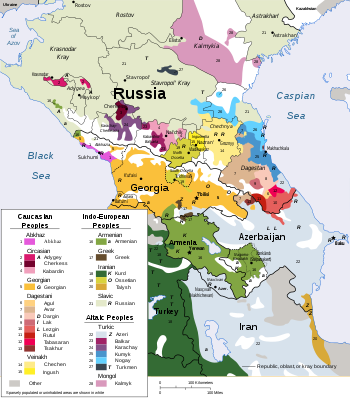Budukh language
Budukh or Budugh (Будад мез, Budad mez[3]) is a Samur language of the Northeast Caucasian language family spoken in parts of the Quba Rayon of Azerbaijan. It is spoken by about 200 of approximately 1,000 ethnic Budukhs.[1]
| Budukh | |
|---|---|
| Будад мез budad mez | |
| Native to | Azerbaijan |
| Region | Quba Rayon |
| Ethnicity | 1,000 (1990)[1] |
Native speakers | 200 (2010)[1] |
Northeast Caucasian
| |
| Language codes | |
| ISO 639-3 | bdk |
| Glottolog | budu1248[2] |
Budukh is a severely endangered language,[4][5] and classified as such by UNESCO's Atlas of the World's Languages in Danger.[6]
Grammar
Gender and agreement
Authier (2010) reports that Budugh has six 'gender-number' classes:
- human masculine,
- human adult feminine,
- animate (which includes animals, plants, and non-adult human females, as well as some abstract nouns),
- inanimate,
- nonhuman plural,
- human plural.
Verbs normally agree with their absolutive argument (intransitive subject or transitive object) in gender. In the following examples, the verb 'beat' shows animate agreement with 'donkey' and non-human plural agreement with 'donkeys'.
| Ma'lla'-cır | lem | ğùvotu-ri |
| Mullah-erg | donkey | animate:beat:present |
| 'Mullah beat the donkey' | ||
| Ma'lla'-cır | lemér | ğùtu-ri |
| Mullah-erg | donkey | nonhumanplural:beat:present |
| 'Mullah beat the donkeys' | ||
Compare these examples with the following, where the verb agrees with the intransitive subject:
| Ma'lla' | vìxhici | |
| Mullah | masculine:go:narrative_tense | |
| 'Mullah went.' | ||
| Lem | vüxhücü | |
| donkey | animate:go:narrative_tense | |
| 'The donkey went.' | ||
Verb agreement
Budukh verbs typically agree with a single argument, the absolutive. In the agreement paradigms, the majority of verbs show no overt agreement for the masculine, neuter, and nonhuman plural. Consider the following paradigm for the verb 'keep' in the perfective (Authier 2009):
| M/N/NPL | ˤa-q-a |
| F | ˤa-ra-q-a |
| A | ˤa-va-q-a |
| HPL | ˤa-ba-q-a |
In this paradigm, /ˤa/ is a preverb which must appear with the verb root /q/ 'keep', and the agreement morphology appears between the preverb and the root. Due to historical changes, the relationships between the various members of an agreement paradigm are often more complex and show changes of vowel and/or consonant. The following perfective paradigm for 'go' shows this (with the reconstructed form shown after the *)
| M | vi-xhi |
| F | v-r-xhi |
| A | vüxhü < *vi-v-xhi |
| N/NPL | vidki < *vi-d-xhi |
| HPL | vibki < *vi-b-xhi |
Word order
Budukh is an SOV language, as seen in the following example:
| Ma'lla'-cır | lemér | ğùtu-ri |
| Mullah-erg | donkey | nonhuman plural:beat:present |
| 'Mullah beat the donkeys' | ||
It has possessors before possessed nouns:
| Mallá-co | rij | |
| Mullah-adlocative | daughter | |
| 'the mullah's daughter' | ||
Adjectives appear before the nouns that they modify:
| q'usú | Mallá' | |
| old | mullah | |
| 'the old mullah' | ||
References
- Authier, Gilles. 2009. Development of Introflexion (Root-and-pattern Morphology) in Budugh Verbs http://www.digitorient.com/wp/wp-content/uploads/2009/12/introflexionBudugh.doc
- Authier, Gilles. 2010. Finite and Non-Finite: Prosodic Distinctions on Budugh Verb Stems. In Clause Linking and Clause Hierarchy: Syntax and Pragmatics, ed. by Isabelle Bril. Amsterdam: John Benjamins. pp 143–164.
- Budukh at Ethnologue (18th ed., 2015)
- Hammarström, Harald; Forkel, Robert; Haspelmath, Martin, eds. (2017). "Budukh". Glottolog 3.0. Jena, Germany: Max Planck Institute for the Science of Human History.
- "The Budukhs". The Red Book of the Peoples of the Russian Empire.
- Published in: Encyclopedia of the world’s endangered languages. Edited by Christopher Moseley. London & New York: Routledge, 2007. 211–280.
- The sociolinguistic situation of the Budukh in Azerbaijan
- UNESCO Interactive Atlas of the World’s Languages in Danger Archived February 22, 2009, at the Wayback Machine
